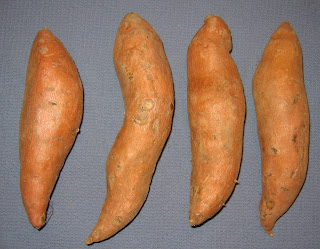On the Lehman's website, they have a tool that allows you to make your own planting pots out of newspapers. You can click here to view it. I have heard rumors that you can also do this with a toilet paper roll so I thought I would give it a try.
I searched for a picture tutorial and couldn't find one so here is what I did:
 I got an empty toilet paper roll that I had saved and a glue stick. Then I cut a bunch of strips of newspaper to about the size of the toilet paper roll. I also ripped them in half down the center fold of the newspaper to get them a length I thought would work well.
I got an empty toilet paper roll that I had saved and a glue stick. Then I cut a bunch of strips of newspaper to about the size of the toilet paper roll. I also ripped them in half down the center fold of the newspaper to get them a length I thought would work well. Next, I wadded up some newspaper and filled the toilet paper roll about half way up. I did this to give it some stability and to have something to pack the bottom of the pot with.
Next, I wadded up some newspaper and filled the toilet paper roll about half way up. I did this to give it some stability and to have something to pack the bottom of the pot with. I then placed the toilet paper roll half way on to the newspaper strip and started rolling. I spread a little glue on the paper where it would start to overlap to hold the inside edge in place. This isn't necessary, but I found it really helps when you go to fill it with soil.
I then placed the toilet paper roll half way on to the newspaper strip and started rolling. I spread a little glue on the paper where it would start to overlap to hold the inside edge in place. This isn't necessary, but I found it really helps when you go to fill it with soil. After that, I continued to roll up the newspaper. As I rolled, I tucked the loose end up inside of the toilet paper tube.
After that, I continued to roll up the newspaper. As I rolled, I tucked the loose end up inside of the toilet paper tube. When I was finished rolling, I put another line of glue to secure the end.
When I was finished rolling, I put another line of glue to secure the end. Then I pushed the remainder of the newspaper overlap up into the toilet paper tube. I didn't find it necessary to use glue here.
Then I pushed the remainder of the newspaper overlap up into the toilet paper tube. I didn't find it necessary to use glue here. After the newspaper was all rolled up, I set the tube on the floor. With my fingers, I pushed down inside of the tube on the paper I had stuffed inside. This packed down the bottom of the pot.
After the newspaper was all rolled up, I set the tube on the floor. With my fingers, I pushed down inside of the tube on the paper I had stuffed inside. This packed down the bottom of the pot. When this was done, I carefully slipped the planting pot off of the toilet paper tube.
When this was done, I carefully slipped the planting pot off of the toilet paper tube. I repeated this process until I had made enough pots. After I had all of the pots I needed, I fit them inside the base of my tray. They fit quite nicely and were snug enough to be stable. I used a plastic spoon to fill them with soil, and then I added the water.
 With the original Jiffy pots needing quite a bit of water to puff up, I added more water than I would have needed to to moisten the homemade planting pots. Even with the newspaper quite saturated, they seemed like they would hold together well. We'll see how it goes!
With the original Jiffy pots needing quite a bit of water to puff up, I added more water than I would have needed to to moisten the homemade planting pots. Even with the newspaper quite saturated, they seemed like they would hold together well. We'll see how it goes!For results of these planting pots, click here.
To see how I changed my seed starting and to view a seed starting timeline I put together, click here.
Follow The Beginning Farmer's Wife on Facebook for additional personal peeks at building a family farm.
Tools of My Trade
Here are a few of the supplies I use for starting my seeds. They can be found in most home and garden departments or through the affiliate links below.These planting trays can be purchased with rehydrating planting discs, which is how my tray came when gifted to me. Instead of disposing of the tray or buying new discs, I made my own planting pots the following year.
Ethan also gifted me two grow lights over the years. Although I keep my plants near a sunny window, these special grow lights help immensely in preventing my seedlings from becoming spindly as they would otherwise stretch to a more direct light source.























